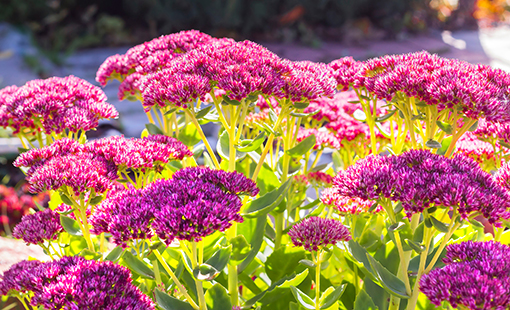
Growing Sedum
Sedum plants come in a wide variety of heights, colors and forms. Also known as stonecrop, most sedums are hardy, drought-tolerant succulents with thick, fleshy leaves that vary in shades. Plus, they typically have tiny, star-shaped flowers that bloom late in the growing season. In general, the large Sedum genus is divided into two categories: low-growing sedum and upright sedum. The low-growing sedum stays short and spreads as a ground cover whereas the upright sedum forms vertical clumps and looks great along borders. The best time to plant sedum is in the spring after the danger of frost has passed but before summer heat arrives. Sedum generally has a moderate growth rate, but this can vary by species and variety.
Care
Because they look good all throughout the growing season, thanks to their interesting foliage and then their flowers, sedums are suitable for mass plantings, as edging and ground cover, and for growing in containers. Sedums also make long-lasting cut flowers and are great for attracting butterflies and other pollinators to your garden.
These plants are extremely low-maintenance. Simply situate them in a spot that has good soil drainage and adequate sunlight, and they’ll practically take care of themselves. They don’t need deadheading (removing spent blooms), and they often look good even into winter. However, extreme heat and a lack of sunlight both can cause sedum plants to get a bit leggy. Cutting back the plants after they are done flowering can help to maintain their shape and encourage bushier, sturdier growth.
Light
Most sedum plants grow best in full sun, meaning at least six hours of direct sunlight on most days. Some varieties can tolerate partial shade, though they often won’t be as sturdy or bloom as profusely as they would in full sun. However, in very hot, dry conditions, many sedum varieties do appreciate a bit of afternoon shade.
Soil
In general, sedum prefers a loose loamy, sandy, or gravelly soil with sharp drainage. When the soil retains too much water, as is often the case with a heavy wet clay soil, this can easily lead to root rot for sedum.
Water
Water new sedum plants roughly once a week to prevent the soil from drying out. Once established, sedum plants typically won’t need any supplemental watering unless you have a long stretch without rainfall and/or very hot temperatures. Thanks to their thick succulent leaves, sedum plants have good drought tolerance.
Temperature and Humidity
Growing zones vary by sedum species. But in general, these plants can tolerate a wide range of temperatures, though very high temperatures (above 90 degrees Fahrenheit) can lead to scorched leaves. Sedum plants also usually tolerate humidity well. However, sharp soil drainage is especially important in areas with high humidity to prevent the plants from sitting in too much moisture.
Fertilizer
Sedum typically needs no supplemental fertilization and can tolerate nutrient-poor soil. In fact, if the soil is too rich, this can cause weak, leggy growth. If you have very poor soil, mixing some compost into it will generally be enough to give your sedum a boost.
Information courtesy of TheSpruce.com

 Adams Fairacre Farms
Adams Fairacre Farms